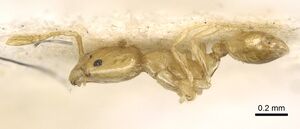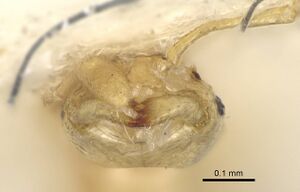Monomorium aeyade
| Monomorium aeyade | |
|---|---|

| |
| Scientific classification | |
| Kingdom: | Animalia |
| Phylum: | Arthropoda |
| Class: | Insecta |
| Order: | Hymenoptera |
| Family: | Formicidae |
| Subfamily: | Myrmicinae |
| Tribe: | Solenopsidini |
| Genus: | Monomorium |
| Species group: | monomorium |
| Species: | M. aeyade |
| Binomial name | |
| Monomorium aeyade Collingwood & Agosti, 1996 | |
Nothing is known of the biology or ecology of this species, which remains known only from the original type material.
Identification
Keys including this Species
Distribution
Distribution based on Regional Taxon Lists
Palaearctic Region: Oman (type locality).
Distribution based on AntMaps
Distribution based on AntWeb specimens
Check data from AntWeb
Countries Occupied
| Number of countries occupied by this species based on AntWiki Regional Taxon Lists. In general, fewer countries occupied indicates a narrower range, while more countries indicates a more widespread species. |

|
Estimated Abundance
| Relative abundance based on number of AntMaps records per species (this species within the purple bar). Fewer records (to the left) indicates a less abundant/encountered species while more records (to the right) indicates more abundant/encountered species. |

|
Biology
Castes
Images from AntWeb
     
| |
| Paratype of Monomorium aeyade. Worker. Specimen code casent0922329. Photographer Michele Esposito, uploaded by California Academy of Sciences. | Owned by NML, Liverpool, UK. |
Nomenclature
The following information is derived from Barry Bolton's Online Catalogue of the Ants of the World.
- aeyade. Monomorium aeyade Collingwood & Agosti, 1996: 341 (w.) OMAN.
- Type-material: neotype worker (by designation of Sharaf, Al Dhafer, et al. 2018: 6).
- [Note: originally described from 2 workers (holotype + paratype), the neotype is apparently the original paratype, as Sharaf, Al Dhafer, et al. 2018: 9, point out that the original holotype has been lost.]
- Type-locality: neotype Oman: Wadi Aeyad, 20.iii.1990 (M.D. Gallagher).
- Type-depository: WMLC.
- Status as species: El-Hawagry, et al. 2013: 73 (in key); Borowiec, L. 2014: 115; Sharaf, Al Dhafer, et al. 2018: 6 (redescription).
- Distribution: Oman.
Unless otherwise noted the text for the remainder of this section is reported from the publication that includes the original description.
Description
Worker
Holotype: TL 1.5; HL 0.38; HW 0.31; CI 81.5; 51 96.8; HW/EL 0.24. Des c rip t ion: These two tiny ants were taken from under a stone in sandy terrain. They resemble Monomorium guillarmodi from Lesotho by their small size and total absence of dorsal alitrunk hairs unlike all other known Monomorium species with 11-segmented antennae. The Arabian species differs from M. guillarmodi by the smaller eyes, the rounded anterior margin of the clypeus and the more rounded promesonotal dorsum. M guillarmodi has 1-2 pairs of hairs on the occipital margin which are absent in M. aeyade. These two, somewhat unique, species are otherwise very similar both being glossy brown with very little sculpture.
Type Material
Holotype: worker, Oman, Wadi Aeyad, 20.III.1990, M.D. Gallagher. - Paratype: 1 worker, same series as holotype.
- Neotype (designated by Sharaf, Al Dhafer et al., 2018: 6), worker, Wadi Aeyad, Oman, 20 March 1990, MD Gallagher, CASENT0922329, World Museum, Liverpool.
Sharaf, Al Dhafer et al. (2018): This species was originally described based on two worker specimens, the holotype and one paratype. During an extensive search in the WMLC collection it was not possible to locate the holotype, which is presumably lost. However, the paratype specimen was available for examination and we designate it as a neotype to unequivocally ascertain the identity of the species.
References
- Borowiec, L. 2014. Catalogue of ants of Europe, the Mediterranean Basin and adjacent regions (Hymenoptera: Formicidae). Genus (Wroclaw) 25(1-2): 1-340.
- Collingwood, C. A. and D. Agosti. 1996. Formicidae (Insecta: Hymenoptera) of Saudi Arabia (part 2). Fauna Saudi Arabia. 15:300-385. (page 341, worker described)
- Sharaf, M., Al Dhafer, H.M., Aldawood, A.S., Hita Garcia, F. 2018. Ants of the Monomorium monomorium species-group (Hymenoptera: Formicidae) in the Arabian Peninsula with description of a new species from southwestern Saudi Arabia. PeerJ 6:e4277, pp. 1-31 (DOI 10.7717/peerj.4277).
- Sharaf, M.R., Mohamed, A.A., Boudinot, B.E., Wetterer, J.K., Hita Garcia, F., Al Dhafer, H.M., Aldawood, A.S. 2021. Monomorium (Hymenoptera: Formicidae) of the Arabian Peninsula with description of two new species, M. heggyi sp. n. and M. khalidi sp. n. PeerJ 9, e10726. (doi:10.7717/peerj.10726).
References based on Global Ant Biodiversity Informatics
- Borowiec L. 2014. Catalogue of ants of Europe, the Mediterranean Basin and adjacent regions (Hymenoptera: Formicidae). Genus (Wroclaw) 25(1-2): 1-340.
- Collingwood, C. A. and D. Agosti. 1996. Formicidae (Insects: Hymenoptera) of Saudi Arabia (Part 2) Fauna of Saudi Arabia 15: 300-385.
- Collingwood, C. A., and Donat Agosti. "Formicidae (Insecta: Hymenoptera) of Saudi Arabia (Part 2)." Fauna of Saudi Arabia 15 (1996): 300-385.
- Sharaf M. R., B. L. Fisher, H. M. Al Dhafer, A. Polaszek, and A. S. Aldawood. 2018. Additions to the ant fauna (Hymenoptera: Formicidae) of Oman: an updated list, new records and a description of two new species. Asian Myrmecology 10: e010004
- Sharaf M., H. M. Al Dhafer, A. S. Aldawood, and F. Hita Garcia. 2018. Ants of the Monomorium monomorium species-group (Hymenoptera: Formicidae) in the Arabian Peninsula with description of a new species from southwestern Saudi Arabia. PeerJ 6:e4277; DOI 10.7717/peerj.4277

